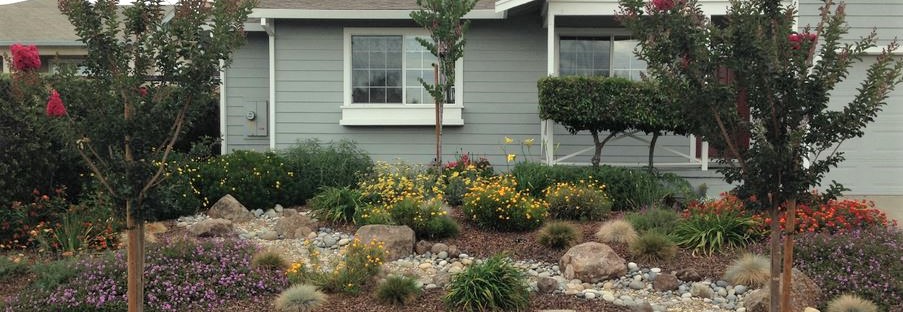
Rain is a renewable, free source of fresh water. Harvested rainwater reduces the need for supplemental irrigation, reduces stormwater overflows, and helps contribute to resilient, climate-appropriate gardens.
Passive Rainwater Catchment and Rain Gardens
Passive rainwater catchment, also referred to as the watershed approach to landscaping, utilizes berms, basins, and dry creeks to capture rainwater within the landscape. Home gardens can serve as mini-watersheds, with high points draining to low points, allowing water to slow, spread, and sink, which prevents runoff and pollution from flowing down storm drains and out to the bay. Passive rainwater catchment also builds healthy soil and attracts essential life into the garden.
Learn more about the watershed approach by downloading the free California Watershed Approach to Landscape Design booklet.
Rain Barrels
Rain barrels are for collecting rainwater from roofs and gutters. To get started follow the steps below:
Step 1: Learn about your roof size and approximate rainwater catchment volume
- Consider roofing material. While any material is usually acceptable, asphalt shingles may leach toxins and should not be used to collect water for vegetable gardens.
- Find the square footage of the roof area adjacent to where you will be connecting the barrel. Multiply length by width, and multiply the results by 0.623 to get the number of gallons per inch of rain.
- Multiply the number of gallons you just found by your area's average inches of rainfall in order to size your barrel and estimate rainwater catchment volume.
Step 2: Purchase equipment
Many hardware stores carry rainwater catchment kits that can be purchased and easily installed. If you choose to create your own system, the best barrels will:
- Have thick walls that can withstand different temperatures.
- Have an easy outlet nozzle for landscape irrigation.
- Be opaque to inhibit algae growth.
- Be securely covered to prevent children and pets from falling inside.
- Be screened to keep out debris and prevent mosquitoes from breeding in the tank.
Step 3: Position the barrel
- The barrel should be located in a safe, stable spot to prevent tipping and discourage animals and children from playing in or around it.
- If the barrel has an outflow valve, it can be placed on cement blocks to make water collection easier.
- As an added precaution, a rope or chain can be used to secure the barrel to the side of a house or shed.
Step 4: Collect rainwater and maintain the system
Both rain gutters and the water catchment system should be inspected and cleaned at least twice a year. To maintain and prolong the life of your rain barrel, you should:
- Inspect the inside of the barrel for cracks and algae.
- Clean the inside of the barrel with vinegar and water.
- Avoid prolonged periods of standing water or add a drop or two of chlorine bleach if needed.